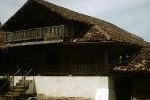
Guanacaste Conservation Area is in the northeastern cantones (counties) of Liberia, La Cruz, Bagaces and Upala, spanning between the provinces of Guanacaste and Alajuela. This area comprises three national parks: Rincón de la Vieja Volcano NP, Guanacaste NP and Santa Rosa-Bolaños island NP, the recreational area of Junquillal, Horizontes experimental station and some smaller protected areas.
The particularity of this part of the country, regarding the rest of the country, is it´s drier climate to the pacific side of the mountain slopes. So, it´s considered the last relict of the dry tropical forest that sometime covered from Guanacaste to southern Mexico. With this respect, it´s the largest area to include such forest. It also has some other important aspects: the large biodiversity that it houses, somewhat different to what is usual in the wetter parts of the country, the savanna-type vegetation, the presence of different species such as: deers, coaties, monkeys, armadillos, snakes, etc. The marine part is also particulary rich and pristine in terms of biodiversity.
Bolaños island is considered a sanctuary for marine birds, Junquillal and Naranjo beaches are extremely appreciated for their waves and rugged landscape, Santa Elena peninsula in Santa Rosa NP is the driest and geologically oldest part in the country and it´s in a great deal untammed by human action, Murciélagos islands are also representative of the historic and biological evolution of the area. Santa Rosa has the biggest section of dry forest, a mariine area, and coastal marshlands, and also has Nancite Beach, …
Keep reading 0 comments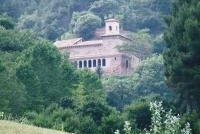
The village of San Millan de la Congolla was picturesque and set in an amazing landscape.
I reached it by a bus that travels there in the afternoon from Logrono via Najera, and returns in the evening allowing several hours for a visit to the Yuso and Suso monasteries.
I found the displays of the earliest books in the Castillian language in the Yuso monastery very interesting. Because the bus to Suso was not operating on the day of my visit I hiked up the hill through the forest to see this ancient building.
Keep reading 0 comments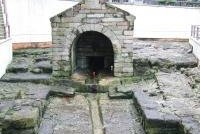
During two days in Oviedo I managed to visit all 6 WHSs.
The Camara Santa (inside the cathedral) contains valuable jewel encrusted relics.
The Foncalada is an ancient spring located in a niche beneath a busy road junction.
St Julian de los Prades church, 1200 years old contains well-preserved frescoes. I reached it by bus #2 from the city centre.
Sta Christina's church I reached from La Cobertoria railway station where nearby there is a signboard showing several paths leading up to the church, some steeper than others.
San Miguel and Sta Maria churches on Monte Naranco I reached by bus #10 to the Cruces car park, from where there are walking tracks to the respective churches.
Keep reading 0 comments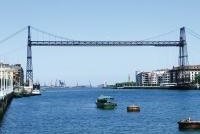
I crossed the river in the gondola for 3 euros. I travelled by local train from Bilbao Abando station to Portugalete enjoying a spectacular view of the bridge while approaching Portugalete station. Having crossed the bridge I went to the nearby Areeta metro station to catch a train back to Bilbao and the Guggenheim Museum.
I believe that this is the world's last remaining operating transporter bridge; I have only seen one other, derilict at La Boca in Buenos Aires, Argentina.
Keep reading 0 comments
When I arrived in Lugo there were Roman legions parading around the Praza Maior and crowds of people dressed in togas were feasting and imbibing at various stalls. But I would imagine that when not in fiesta mode it is fairly ordinary.
But the town's walls are extraordinary for their thickness, elaborate archways and the continuous walkway around the top.
Keep reading 0 comments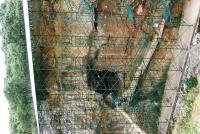
My visit to Atapuerca was only to the Yacimentos (excavations) and not to the archaeological park. The visit involved taking a bus to the village of Ibeas de Juarro (on the Burgos to Logrono route), where there is a visitors centre and small museum about Atapuerca. From Ibeas it is a 3km hike to the entrance of the railway cutting where the excavations start, and from there, there is a track which follows the top of the cutting. These excavations are still ongoing and a fenced off for security, but I got a birds eye view of the Suiva del Elefanta, the Galeria and the Gran Dolina.
Keep reading 0 comments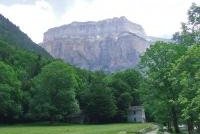
The scenery in the Ordesa Valley I found reminiscent of that of Yosemite: high rock walls with numerous waterfalls. I reached the park by travelling by bus from Sabananigo (on the Jaca to Zaragoza rail line) to the attractive village of Torla. After paying the 4.50 euros to enter the Ordesa National Park I boarded the free bus that stopped first at the visitor centre at the entrance to the park, then at the Pradera car park inside the park. This is the starting point for a number of walking tracks around the park. By following the Rio Arazas to the WHS plaque I reached the view of Mount Perdido.
Keep reading 0 comments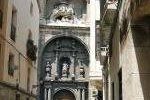
During my visits to the Route of Santiago I saw many groups of pilgrims walking and cycling towards Santiago de Compostela. I also met up with them at overnight stops where I noticed that restaurants were open to pilgrims at all hours, not just at traditional Spanish meal times. I did not walk the Route myself, but visited a number of the sites that were accessible by bus and train, such as:
Jaca, the cathedral, ayuntemento, citadel and St Michael's Bridge.
Puenta La Reina (Aragon), bridge
Najera, the Monastery of Sta Maria la Reale
Logrono, church of St James
Puenta La Reina (Navarra),the Roman bridge and the churches of St James and the Crucifixion
Estella, the church of San Pedro de la Rua
Santo Domingo de la Calzada, cathedral and hermitage
Fromista, the recently restored St Martin's church,
Astorga, the cathedral (closed) and Gaudi's episcopal palace
Leon, the cathedral and San Isidoro's church
Ponferrada, the Templar castle
Keep reading 0 commentsI spent nearly three months on Quirimba Island in the summer of 1996. As part of a volunteer team we spent our days researching the surrounding reefs of the archipelago and joining the fishing fleet to 'count' catches. Quite simply the most memorable summer of my life. A beautiful place and amazing people.
Keep reading 0 comments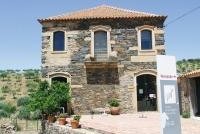
The rock engravings are difficult to see and nowhere near as stunning as those of Alta (Norway) or Tanum (Sweden).
However having reached Pocinho by train, it was only a short ride by minibus to Vila Nova de Foz Coa. Here I visited the Archaeology Park office and manged to arrange a visit to the Penascosa site. This involved taking the same minibus to Castelo Melhor, a village about 10 km away. From the reception centre in the village I joined a guided tour (costing 7 euros) by 4WD down into the valley to see a number of the engravings.
Keep reading 0 comments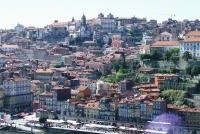
Although there are a lot of steep hills to negotiate while visiting the sites here, there are a number of usful tram and bus routes that connect the different levels of the city. I too found the azuelejos impressive, especially those in the foyer of Sao Bento station and on the facade Congregados church. The Carmo church, city hall, Misericordia church and the Palacio da Bolsa were interesting architecturally, although after a while I found the predominant grey stone a bit depressing.
Keep reading 0 comments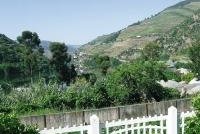
I found the most relaxing way of visiting the Alto Douro was to take the train from Porto to Pocinho and back. The train runs up the valley with excellent views of the rocky gorges, the vinyards and wineries.
Keep reading 0 comments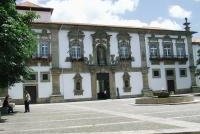
Other interesting features in Guimaraes were the five Stations of the Cross to be found around the town, the church of Our Lady of the Olive Tree and the Santa Clara convent.
Keep reading 0 comments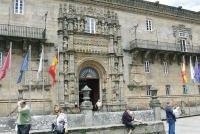
For the town at the focus of the Route of Santiago de Compostela (listed 1993) it came as an anticlimax for me. The town had little of historical or cultural interest besides the cathedral.
Arriving at the railway station the consigna was closed and there was little information on how to reach the cathedral. So I took my luggage on a #6 bus to Praza de Galicia and walked to the cathdral from there. The external staircases are fine and the interior embellishments of the altar and chancel well executed, but not of outstanding universal value.
Keep reading 0 comments
The monastery is located on the outskirts of the modern town of Maulbronn. The Cistercians choose this spot for its favourable agricultural conditions - not because of reasons of seclusion. It really is a "complex", behind its walls lies a large square with several public buildings, a mill, a bakery and the monastery of course.
I arrived already at 9.15 a.m. The people at the reception gave me a bewildered look, but sold me an entrance ticket for 6 EUR anyway. There were no other visitors yet. The only people around were about 20 regional craftsmen that were preparing their stalls for an Easter market.
So I wandered around alone in the monastery too. It was a dark and cold morning, which gave some extra gloom to the already austere surroundings. There's not a lot of frivolities to see inside apart from some faded frescoes. Most impressive are the large halls where the monks and the lay brothers (separately) used to dine.
What I liked most about this WHS was its intact surroundings. The timber-framed buildings on-site look very authentic, you just wait for the medieval fair to start. They now have modern use (as a restaurant, wedding chapel, museum, city hall). On the hill, the terraces and vineyards developed by the monks can still be seen.
Keep reading 0 comments
The imposing structure of the Strasbourg Cathedral can best be admired from afar. Already kilometers before entering the old town by car, the cathedral’s spire dominates the skyline. What a sight this must have been during the Middle Ages when the area wasn’t as built up as it is now. It has inspired Cologne Cathedral – and indeed they look alike apart from the exterior colour.
This was my second visit to Strasbourg. I had visited it before in 1981 with my parents. I had ‘counted’ that as a WHS visit but always felt a bit bad about this because I had no memories of it at all. Now, over Easter, I stayed in Strasbourg for two nights on a proper visit. I found a town very popular with German tourists. Also, the Asian tour groups know how to find it. There are plenty of restaurants too and it’s all quite touristy.
On Easter morning I started with a walk along the River Ill. There are cheesy boat trips on offer here, like in Amsterdam or Paris. I continued on foot to the bulky St. Thomas Church, dating from 1196. From there a footpath starts into the Petite France neighbourhood. This is the main tourist area with pretty Fachwerk houses and streets named after the guilds.
Then it was on to Palais Rohan. A pretty 18th-century palace that houses three museums. The entrance was free today, and I choose the Museum of Beaux Arts. It has numerous …
Keep reading 0 comments
The wrought iron gates with gilded ornaments are the trademark of Place Stanislas. All corners of the square have these gates, so this is the first thing you see when approaching. Wow! The surrounding buildings all are in the same style, as they were carried out within a short period and by the same team.
Place d’Alliance, about 200m eastwards from Place Stanislas, is a whole different experience. It’s a small square surrounded by trees. It looks quite dilapidated, due to a lot of dog shit on the ground and the paint of the monumental Hotel d’Alsace is definitely peeled. The masterpiece here is the fountain that was modelled after the one at Piazza Navona in Rome.
Place de la Carrière is the most classical of the three squares. It lies behind the Arc de Triomphe, on the north side of Place Stanislas. It ends in a semi-circular monument that holds the Palais du Gouvernement.
I visited the squares on foot for about 1.5 hours. I used a walking tour and map that I found at my hotel. There are some other interesting sights underway, like Art Nouveau buildings and an old city gate. It's a nice walk to stretch your legs. The Place Stanislas surely is the major thing to see here.
Keep reading 0 comments
I have been lucky enough to visit Abu Simbel several times, and also managed to time one of these visits to coincide with the sunrise lighting up the statues at the back of the temple. I am as much in awe of the rescue of Abu Simbel as of its original construction. I also visited the monuments on Lake Nasser a few years ago, and plan to return in 2011.
The UNESCO campaign of the 1960's impressed me so much that I decided to base my dissertation for my MA in Egyptian Archaeology on the rescued Nubian monuments. I am using them as a case study, to measure to what extent the rescue - but subsequent removal to other countries - has enabled a wider understanding of the original culture.
As a tool to help me collect people's opinions, I have created my own website explaining my project, and including a blog. I would very much appreciate receiving your comments, and those of your readers. I also hope to publish a link to a survey soon on my website, but I need to increase readership first to make this worthwhile. The site is here www.whithernubia.co.uk
Keep up the good work!
Keep reading 0 comments
The blue and white tile panels at Alcobaca station are also interesting, depicting scenes from the Holy Land.
The station is at Valado, some distance from the monastery. Connecting buses are available during the week, but at the weekend there are only taxis.
Keep reading 0 comments
I agree with David that there is much of value to see here, and with Ann regarding the magnificent aqueduct.
But the experience for me was marred by the traffic and huge car parks that obstruct views of the sites. These should be removed well away from the city walls.
Keep reading 0 comments